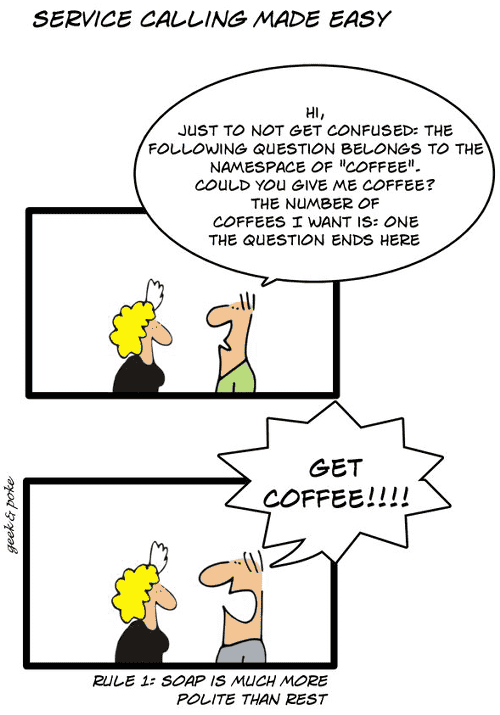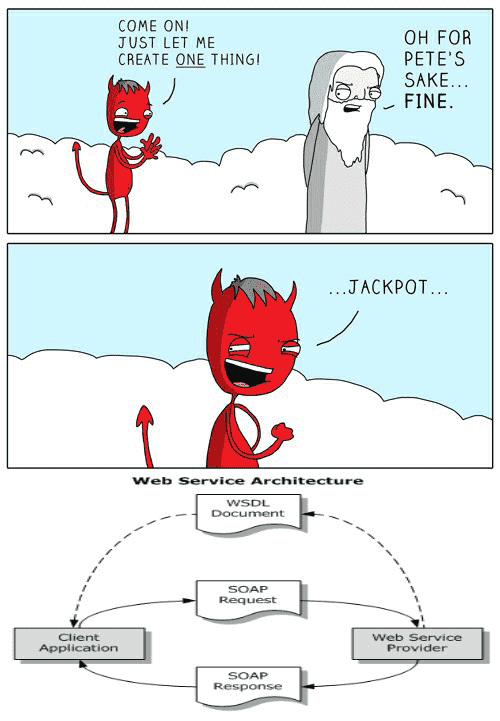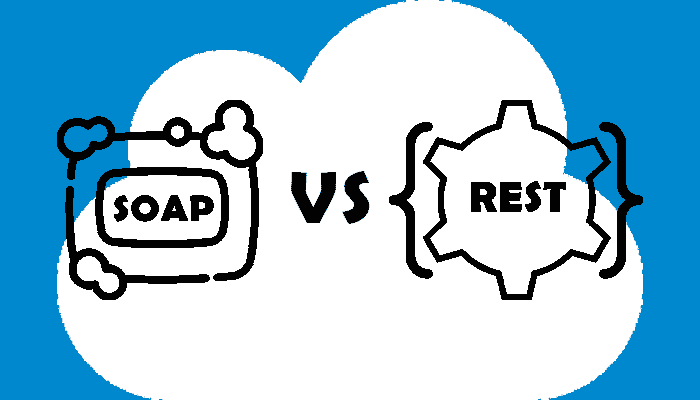Introduction
REST and SOAP are two different methods of transferring data over the Internet. Specifically, both define how application programming interfaces (APIs) are built.
An API (Application Programming Interface) is offered by both the client and server. In the client this is offered by the browser while in the server it is what is provided by the web service. An API usually sticks to either REST or SOAP, depending on the use case and developer preferences.
REST and SOAP have important differences that are often overlooked. The main difference is that SOAP is a protocol while REST is not.
SOAP is an official protocol maintained by the World Wide Web Consortium (W3C) and has long been the standard approach for web service interfaces, although it has been dominated by REST in recent years.
REST is a set of architectural principles and is usually considered easier to interact with, especially for public APIs, but SOAP is still used and preferred for specific use cases.
When creating a new web service, what is the appropriate approach for your use case?

Each technique has its advantages and disadvantages. Hence, it is always good to understand the situations in which each design should be used.
What is SOAP?
SOAP (Simple Object Access Protocol) is a protocol that was designed well before REST. The main idea behind the design of SOAP was to ensure that programs built on different platforms and programming languages could easily exchange data.
What is REST?
REST (Representational State Transfer) is specifically designed to work with components such as media, files, or even objects on a specific device. Any web service defined according to REST principles can be called a RESTful web service. A RESTful service will use the regular HTTP verbs of GET, POST, PUT and DELETE to work with the required components.
The Similarities
While SOAP and REST share similarities over HTTP, SOAP has a much stricter set of messaging patterns than REST. The rules in SOAP are important because we cannot achieve any level of standardization without them. REST as an architecture method does not require processing and is naturally more flexible.
Both SOAP and REST are based on well-established rules that everyone has agreed to abide by in the interest of information exchange.
Difference Between SOAP and REST
REST works through a single, consistent interface to access named resources. It is used more when you expose a public API over the Internet. On the other hand, SOAP exposes application logic components as services, not data. In addition, it works through different interfaces.
To put it simply, REST accesses the data while SOAP performs operations through a more standardized set of messaging patterns. However, in most cases either REST or SOAP can be used to achieve the same result, with slight differences in how they are configured.

SOAP was originally created by Microsoft and has been around for much longer than REST. This gives it the advantage of being a well-established, legacy protocol. However, REST has been around for a good while now too. Additionally, REST can access web services in a much simpler way than is possible with SOAP using HTTP.
Here are the main differences between SOAP and REST APIs:
SOAP | REST |
SOAP is a protocol. SOAP is designed with certain specifications. It includes a WSDL file that contains the required information about what the web service does as well as the location of the web service. | REST is an architectural style in which a web service can only be treated as a RESTful service if it follows the constraints of being:
|
SOAP cannot take advantage of REST because SOAP is a protocol and REST is an architectural pattern. | REST can make use of SOAP as the primary protocol for web services, because in the end it is just an architectural pattern. |
SOAP uses service interfaces to expose its functionality to client applications. In SOAP, a WSDL file provides the client with necessary information that can be used to understand what services a web service can provide. | REST use Uniform Resource Locators to access components on the device. For example, if there is an object representing user data hosted on a URL like http://techievor.demo, here are some URIs that can exist to access it:
|
SOAP requires more bandwidth to use. Since SOAP messages have a lot of information inside them, the amount of data transfer using SOAP is generally a lot. | REST does not require a large amount of bandwidth when sending requests to the server. REST messages are mostly JSON messages. Below is an example of a JSON message passed to a web server. You can see that the message size is relatively smaller than soap. |
SOAP can only work with XML format, and as such all data is passed in XML format. | REST allows different data format such as plain text, HTML, XML, JSON, etc. But the most preferred format for data transfer is JSON. |
Key Differences
- SOAP is a protocol while REST is an architectural pattern.
- SOAP uses service interfaces to expose its functionality to client applications while REST uses Uniform Resource Locators to access components on a device.
- SOAP needs more bandwidth to use while REST does not need much bandwidth.
- SOAP only works with XML formats while REST works with plain text, XML, HTML and JSON.
- SOAP cannot make use of REST while REST can make use of SOAP.
When to use REST?
One of the most controversial topics is when to use REST or when to use SOAP while designing web services. Here are some of the main factors that determine when REST should be used for web services:
- Limited Resources and Bandwidth – Because SOAP messages are heavier in content and take up much more bandwidth, REST should be used in cases where network bandwidth is a limitation.
- Statelessness – If there is no need to maintain the state of information from one request to another, then REST should be used. If you need a proper information flow where some information must flow from one request to another, SOAP is more suited for this.
- For example, take any e-commerce site. Usually, these sites first need the user to add the items to be purchased to the shopping cart. All items in the shopping cart are then taken to the checkout page to complete the purchase. In this example, the app needs the state feature. The state of the cart items must be moved to the checkout page for further processing.
- Caching – If a lot of requests need to be cached, REST is the perfect solution.
- For instance, clients could request for the same resource multiple times. This can increase the number of requests being sent to the server. By implementing a cache, the results of the most common queries can be stored in an intermediate location. Therefore, whenever a client requests a resource, it will first check the cache. If the resources are there, it will not go to the server. Caching can help reduce the number of calls made to the web server.
- Ease of Coding – Coding REST services and later implementation is much easier than SOAP. So, if a quick solution is required for web services, REST is the way to go.
Benefits of REST Over SOAP
In addition to using HTTP for simplicity, REST offers several other advantages over SOAP:
- REST allows for a wider range of data formats, while SOAP only allows XML.
- REST with JSON (which usually works better with data and provides faster parsing), is generally easier to work with.
- REST with JSON offers better support for browser clients.
- REST provides superior performance, especially by caching information that is not changed and is not dynamic.
- REST is the protocol often used for major services like Yahoo, eBay, Amazon, and even Google.
- REST is generally faster and uses less bandwidth. It is also easier to integrate with existing websites without having to rebuild the website infrastructure. This allows developers to work faster instead of spending time rewriting a site from scratch. Instead, they can simply add additional functionality.
However, SOAP remains the preferred protocol for some use cases. The consensus among experts these days is that REST is usually the preferred protocol unless there is a compelling reason to use SOAP.
Challenges in REST API
- Lack of Security – REST does not enforce any kind of security like SOAP. Therefore, REST is very suitable for publicly available URLs, but when it comes down to confidential data being passed between client and server, REST is the worst mechanism used for web services.
- Lack of State – Most web applications require a stateful mechanism.
- For example, if you have an e-commerce site that has the feature of a shopping cart, it is necessary to know the number of items in the shopping cart before making the actual purchase. Unfortunately, the burden of maintaining this state falls on the client, which just makes the client application heavier and difficult to maintain.
When to use SOAP?
SOAP should be used in the following instances:
- Asynchronous Processing and Subsequent Invocation – If the client has requirements for a guaranteed level of reliability and security, the new SOAP standard for SOAP 1.2 provides a lot of additional features, especially when it comes to security.
- A Formal Means of Communication – If both the client and server have a strict set of rules in the exchange format, then SOAP 1.2 gives the specification for this type of interaction.
- Let us use the example of an e-commerce site again where users add items to the cart before making a payment. Suppose there is a web service that does the final payment. There can be an unequivocal agreement that the web service will only accept the cart item name, unit price, and quantity. In such a scenario, it is always better to use SOAP.
- Stateful Operations – If an application requires that state be maintained from one request to the next, the SOAP 1.2 standard provides the WS* architecture to support these requirements.
Benefits of SOAP Over REST
Since you can achieve most results using either protocol, it is sometimes a matter of personal preference. However, there are some use cases for which SOAP tends to be more appropriate.
For example, if you need more robust security, SOAP support for WS-Security can come in handy. It offers some additional guarantees of data privacy and integrity. It also provides support for identity verification through intermediaries rather than just point-to-point, as provided by SSL (which is supported by both SOAP and REST).
Another advantage of SOAP is that it provides built-in retry logic to compensate for failed connections. On the other hand, REST does not have a built-in messaging system. If the connection fails, the client must deal with it by retrying. There is also no standard set of rules for REST. This means that both parties (service and consumer) need to understand both content and context.
Other benefits of SOAP include:
- The HTTP standard for SOAP makes it easy to operate across firewalls and proxies without making modifications to SOAP itself. But because it uses the complex XML format, it tends to be slower compared to middleware like ICE and COBRA.
- While it is rarely needed, some use cases require greater transaction reliability than can be achieved with HTTP (which limits REST to this capacity). If you need ACID compliant transactions, SOAP is the way to go.
- In some cases, designing SOAP services may be less complex compared to REST. For web services that support complex operations, which require content and context, designing a SOAP service requires less coding at the application layer for transactions, security, trust, and other elements.
- SOAP is highly scalable through other protocols and technologies. In addition to WS-Security, SOAP supports WS-Addressing, WS-Coordination, WS-ReliableMessaging, and a host of other web services standards. A full list can be found on W3C.
Challenges With SOAP API
- WSDL File - One of the main challenges of the SOAP is the WSDL document itself. The WSDL document is what tells the client all the operations that a web service can perform. The WSDL document will contain all information such what types of data are used in SOAP messages and what all operations are available via the web service. The code snippet below is just part of a sample WSDL file.
<?xml version="1.0"?>
<definitions name="Example"
targetNamespace="http://techievor.demo.com/Tutorial.wsdl"
xmlns:tns="http://techievor.demo.com/Example.wsdl"
xmlns:xsd1="http:// techievor.demo.com/ Example.xsd"
xmlns:soap="http://schemas.xmlsoap.org/wsdl/soap/"
xmlns="http://schemas.xmlsoap.org/wsdl/">
<types>
<schema targetNamespace=http:// techievor.demo.com/ Example.xsd
xmlns="http://www.w3.org/2000/10/XMLSchema">
<element name="ExampleNameRequest">
<complexType>
<all>
<element name="ExampleName" type="string"/>
</all>
</complexType>
</element>
<element name="ExampleIDRequest">
<complexType>
<all>
<element name="ExampleID" type="number"/>
</all>
</complexType>
</element>
</schema>
</types>
</definitions>According to the above WSDL file, we have an element called ExampleName which is of type String and is part of the ExampleNameRequest element.
Now, let us say if the WSDL file changes per the business requirements and ExampleName should become ExampleDescription. This means that all clients currently connecting to this web service will then need to make this corresponding change in their code to accommodate the change in the WSDL file.
This demonstrates the biggest challenge to the WSDL file is the tight contract between client and server, and that a single change can cause a significant impact, in general, on client applications.

- Document Size – Another major challenge is the volume of the SOAP messages that are transferred from the client to the server. Because of the large messages, using SOAP in places where bandwidth is a limitation can be a big problem.
Conclusion
Ultimately, the best protocol is what makes the most sense for the organization, the types of clients that you need to support, and what you need in terms of flexibility. Most new APIs are built with REST and JSON usually because of less bandwidth consumption. REST also makes it easier for developers to understand when implementing raw APIs as well as other developers who may be writing other services against them.
Since it is easy for most web browsers today to consume, REST with JSON has become the standard for many public APIs. However, SOAP remains a valuable protocol in some circumstances, and you do not have to look far to find developers advocating for SOAP in specific use cases.
What are your thoughts on REST vs SOAP APIs? Was there something we missed you want to share? Please leave your feedback and questions in the comments below.

